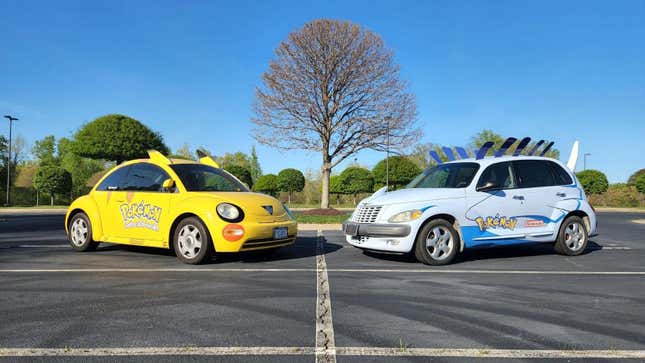In 1998, Nintendo was in the early years of promoting Pokémon while Game Freak’s monster-capturing phenomenon was making its way to the west after success in Japan. Part of that effort included repurposing 20 Volkswagen Beetle cars to look like Pikachu, the series’ adorable, electric mouse mascot, complete with pointed ears on the roof, red cheeks underneath the headlights, and the signature lightning bolt tail coming out of the trunk. These cars were used at events, traveled to malls and toy shops, and housed Nintendo 64 consoles for fans to play games on. After the company was done with them, the cars were given away in contests. Now, collectors are searching for the Beetles, and archivist Grace Klich has one parked at her Virginia home.
Klich, who is known as @mewisme700 on platforms like TikTok, YouTube, and Instagram, has been collecting vintage Pokémon merch since 2010 when she was in high school. While some fans best know Pikachu and all his friends from video games or the anime, Klich tells Kotaku that merchandise has always been her biggest attachment to the franchise. This has been in service of preserving Pokémon’s forgotten history, which extends to the Pikachu Volkswagen Beetle.

Welcome to Exp. Share, Kotaku’s Pokémon column in which we dive deep to explore notable characters, urban legends, communities, and just plain weird quirks from throughout the Pokémon franchise.
These 20 cars (two additional vehicles were made by FAO Schwarz) were originally used in promotional events, including one in Topeka, Kansas. Each of them were numbered, and Klich has the seventh one. By the time the Pikachu Beetle car started circulating through collector circles, it had been repurposed to promote Pokémon 3: The Movie. Initially, the cars were given away in a contest held by Warner Bros. and AOL for the movie, and the winner of Pikabug #7 lived in Norfolk, Virginia, about two hours away from Klich. After some time, the winner gave the car to a family friend.
Klich had heard stories in high school that one of these cars was somewhere in Virginia and even tried calling the DMV to find it. As it turns out, the car wouldn’t enter her sightline until much later when she stumbled upon a listing for it on Facebook in 2019.
“[The previous owner] was having all these issues with it and was just tired of messing with it and was selling it,” she said. “I was just like, ‘I can get it tomorrow. I will be there, like, I’m only two hours away, like, please let me buy this car.’ He had tons of interest in it, and he ended up selling it to me just because I was so close and I was pretty well knowledgeable on the car itself.”
Klich says Pikabug #7 was in “rough shape” when she first got it, as it had been mostly sitting in a field for several years by the time it was listed on Facebook. In the years since she bought it, she estimates she’s spent around $6,000 in repairs and registration taxes, at least $1,000 of which went toward fixing the tail on the trunk. However, the car recently became eligible for antique plates, meaning she no longer has to pay for registration state inspection. After years of repairs, Klich says she mostly just has minor bodywork left, but it took quite a bit of time and money to get there.
“The previous owner was in an accident with it. So it has some very minor damage on the back bumper,” she said. “And then the hood has a dent, but otherwise, like, I have completely gutted it and replaced the inside. It had a lot of mold damage, and it was a mess. I don’t know if you ever sat in a new Beetle, but their insides are horrible. They are like just cheap plastic junk. They’re terrible. So I had all the inside replaced. That is an older car. I have to spend a lot of money trying to keep the thing going. […] Thank God, that has been such a process to get on. But I’m very excited that it’s so close to being done.”
The others are likely still out there in one form or another. As such, she’s been in contact with a handful of collectors in Kentucky, Mexico, and elsewhere in Virginia who own the other parts of the set, while some remain unaccounted for. Though she knows about sightings in Wisconsin and Pennsylvania.
“There was one that a car dealership owns in Illinois that’s been on display for years. I’ve actually been talking with the car dealership and they just use it kind of as like an eye-catcher in their parking lot,” Klich said. “I ran the Carfax on it. It is an official Pikachu car, and a lot of people like on my TikTok will be like, ‘Oh my gosh, there’s one in Chicago. I’ve seen the one in Chicago, and it is an official one.’ I kind of makes me sad that it’s a billboard, but I’m just happy that it exists.”

Despite being in contact with other collectors and knowing the location of other Pikachu cars, Klich says she’s content with the one she has and isn’t looking to buy up any of the others. Though she also has a Lugia PT Cruiser, which was part of the Gold and Silver marketing campaign. With just five produced, these cars modeled after the psychic/flying bird are far more rare. Klich managed to find one through a Facebook group dedicated to the Pikachu Beetle. When she posted a photo of her hers, someone messaged her about the Lugia Cruiser, resulting in the sale.
“I made him an offer and had it shipped here I’m beyond thankful and blessed by the Pokémon gods that I have it,” Klich said. “But I’m good. No more Pokémon cars. Two is plenty. I’m broke as it is with the two.”
Since fixing up the Beetle, Klich now takes the car to anime conventions. Initially, she would display the car at events and allow people to take photos in the car for a fee, but now she sells her own merchandise (often based on old Pokémon items) to fund her work. It’s also become a centerpiece in her online platform and community, with social media platforms like TikTok helping her draw in vintage Pokémon merch fans. According to Klich, the platform she’s built has been key to her and others in archivist work finding new media and merchandise to document Pokémon’s lost history. That means finding old promotional materials, footage of the Pokémon Center New York store, or images and video of original promotional events that featured the Pikachu cars. She hopes her reach online will encourage people to come forward with pieces of history they may not realize they have.
“A lot of archiving is a waiting game,” she said. “It’s waiting for people to come forward with stuff because we didn’t have digital media. And so I’m sure there’s tons of footage sitting on VHS tapes in people’s closets and attics all across America. It’s just a matter of people coming forward with them and digitizing them and uploading them online.”
Klich says she first gained interest in Pokémon archival work because of the now-defunct Pokémon Center New York flagship store.
“I was looking at merch from there, and I realized how much the internet was lacking in information on the store. And that was kind of my first piece of archival work, was working on a website to essentially gather as much information as I could about this defunct store. So before that website, the store was basically lost to time,” she said.
Because of that focus on preservation, much of Klich’s collection is made up of some oddball items. Examples include wrappers for Pokémon popsicles, unused Colgate toothpaste emblazoned with Pikachu’s face, and old promotional cereal boxes.
“I love myself a good hunt for hard-to-find merch,” she said. “That’s kind of why I’m not into cards. I don’t think it’s interesting when I can just go on eBay and buy essentially any card that I want. Obviously, there’s some exclusions to that, like specialty cards and stuff. But for the most part, you know, you can just buy whatever card you want on eBay. And I like things that are a little bit more difficult to find, things that people look at my collection and think, man, I totally forgot about that existing, you know, things that people didn’t think to keep, you know, things that were thrown out.”

But beyond the already elusive candy wrappers and cereal boxes, a great deal of digital media from the time has become nearly impossible to preserve. The demise of Flash, for instance, has made it nigh impossible to find viewable images and videos of Pokémon events from the 90s period Klich focuses on.
“I know there was a lot of footage of the launch Pokémon event in Topeka, Kansas, listed on the website for the Topeka Capital-Journal,” she said. “It was all archived on the site, but it would not let me download any of that video footage, which was just devastating because there’s no footage from that event besides like a few clips. So yeah, sometimes it’ll work. I’ve gotten footage to work before, but it is like once in a blue moon.”
Klich notes that she prefers the neglected sides of the franchise that haven’t been kept up with. Alongside merch, she tries to find information about old promotional events like a live-action pirate ship show that took place in Australia, which is only documented through tiny magazine articles. These events might have been forgotten by some, but were likely exciting and formative for young fans in the early days of Pokémon. Klich doesn’t want this era of the series to be lost just because we didn’t have the same tools to document these moments we do now.
“We got to know the history of the greatest franchise ever and of every piece of history, even the weird and obscure events,” she said. “It’s important. At some point in time, that event made hundreds of kids happy. Like that was the highlight of their little child life. It’s important to make sure that these events don’t get forgotten to time. So, that’s what I’m trying to do as an archivist making sure this stuff doesn’t get forgotten.”

















